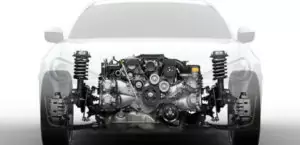The 2.0-liter Mazda FE3N engine was assembled at the company’s Japanese plant from 1989 to 1997 and installed in the local version of the Capella sedan or GD and station wagon or GV models. On Mazda sports cars, there is a turbo modification with an FE3T index of 260 hp.
The F-engine family includes: F6, FP, FP‑DE, F8, FE, FE‑DE, FE3N, FS, FS‑DE, FS‑ZE, F2.
The engine was installed on:
- Mazda Capella GD in 1989 – 1991;
- Mazda Capella GV in 1989 – 1997.
Specifications
| Production years | 1989-1997 |
| Displacement, cc | 1998 |
| Fuel system | injector |
| Power output, hp | 150 – 170 |
| Torque output, Nm | 180 – 190 |
| Cylinder block | cast iron R4 |
| Block head | aluminum 16v |
| Cylinder bore, mm | 86 |
| Piston stroke, mm | 86 |
| Compression ratio | 9.5 – 10.2 |
| Features | DOHC, VRIS |
| Hydraulic lifters | yes |
| Timing drive | belt |
| Phase regulator | no |
| Turbocharging | no |
| Recommended engine oil | 5W-30 |
| Engine oil capacity, liter | 3.9 |
| Fuel type | petrol |
| Euro standards | EURO 2 |
| Fuel consumption, L/100 km (for Mazda Capella Wagon 1996) — city — highway — combined |
12.3 7.9 9.4 |
| Engine lifespan, km | ~250 000 |
| Weight, kg | 168.7 |
Disadvantages of the Mazda FE3N engine
- Despite the high degree of forcing, the engine is reliable and with a good resource;
- The aluminum head is very afraid of overheating, and hydraulic lifters are afraid of low-quality oil;
- After 200,000 km, oil scraper rings often lie and lubricant consumption appears;
- The timing belt is designed for 60,000 km, and with sports pistons, when it breaks, the valves will bend;
- Minor engine problems include oil leaks and the vagaries of the ignition system.






